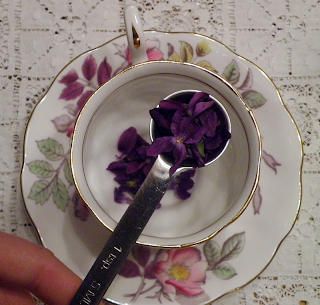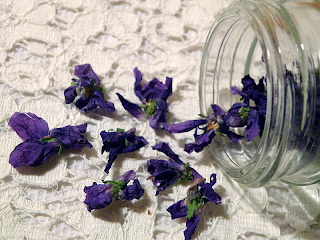 |
| Blue Food |
In the immortal words of George Carlin, “Why is there no
blue food? “ According to The
Straight Dope, it’s because leaves are green. If they were orange, we’d
have plenty of blue fruits and vegetables. It seems that Mother Nature wants to
set up the maximum color contrast between foliage and flowers or fruits. This
contrast helps animals find flowers to pollinate and fruits to eat. Plants
actually benefit when animals eat their fruits. Since plants can’t move much,
they rely on animals to transport seeds and "plant" them in other locations.
 |
| Measuring Fresh Violets |
Leaves are green, so their visual opposite is red. Both
major fruit and veggie pigments, carotinoids (yellow to red) and anthocyanins
(red to blue), have red components. So even if a vegetable has blue pigment, it
is likely to have red as well, rendering it purplish. Orange’s visual opposite
is blue, so if leaves were orange, we’d see a lot more blue flowers, fruits,
and veggies. But orange foliage? Not sure I’m ready for that.
I know some readers are thinking, “But blueberries are
blue!” George Carlin dismisses blueberries as “blue on the vine, but purple on
the plate.” However, I recently discovered a food that’s purple on the vine but
blue on the plate, or in the cup, more accurately. It’s the violets I
harvested and dried last February. I have seen violet syrup and violet tea
in a beautiful purple hue, and yet when I made tea from both fresh and dry
violets, it came out bright blue. Perhaps a better question than “Why is there
no blue food” is “Does anyone really want to eat blue food?” I tried it twice, and
for me the answer is no.
 |
| Looking Suspiciously Blue, not Purple |
I give this recipe high marks for novelty, but can’t say I’d
try it again immediately. Its floral taste is much more subtle than rose or
jasmine, and not really as pleasant. Its slight sweetness is best when enhanced
by floating one or two crystallized violets
in the finished tea, which makes it pleasant but not memorable. There is an
earthiness to the tea, and the dried violets make a rather unpleasant sediment,
so beware of drinking the last drop. However, this tea does have potential for
naturally dying Easter eggs next week.
Dried violets have a slight floral scent and visual appeal,
which makes them good candidates for potpourri. They actually taste somewhat
sweet and earthy when eaten by themselves shortly after drying. Try it if you
dare.
 |
| Store Dried Violets in Airtight Jar |
Dried Violets
According to ehow.com,
you can dry herbs, including violets, in a cool oven overnight. Turn the oven
light on in an electric range. Gas ranges will dry the herbs without light if
the pilot light is on.
I tried the second, faster method. Sandwich violets between
two layers of paper towels on a plate. Microwave on “reheat” setting for 30
seconds. Remove from microwave, and take off top paper towel layer. Allow
moisture to evaporate as they cool completely. Cover again and repeat process.
By now violets will be fairly shrunken. When completely cool, re-cover and
microwave a third time for 30 seconds. Violets will be almost dry. Remove them
to another paper towel or porous surface and let sit for a few hours in a dry
room. When completely dry, store in airtight jar.
 |
| Dried Violet Tea with Crystallized Violet |
Violet Tea
Place about 2 tsp. fresh violets per (6 oz.) cup in the
bottom of a warmed teapot. Add the appropriate number of (6 oz.) cups of
boiling water. Let steep for about 7 - 10 minutes. Strain and pour into cups.
Serve with sugar, honey, or crystallized
violets.
Or, use dried violets and brew tea in individual cups: Place
2 tsp. dried violets in tea strainer in teacup. Fill with boiling water. Let
steep about 5 minutes, lifting strainer in and out of the cup to mix hot water
through it. Serve with honey, sugar, or float some crystallized
violets on top.
I have also heard that violet tea can be made with half
violet leaves and half violet flowers. Violet leaves are healthfully high in
vitamin C, and have been used in traditional
spring tonics. Assuming that you’re braver than I am…let me know how violet
flower/leaf tea is.
I recently tried making the tea with leaves in. It was fairly good, and the color was seafoam-ish. Pics here:
ReplyDeletehttp://thehappyherbologist.blogspot.com/2013/04/going-wild-with-violets-pt-2-violet-tea.html
It does look appealing the way you've served it in stemware and garnished with fresh violets. Thanks for sharing! :)
Delete